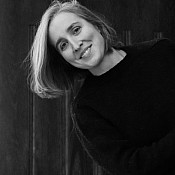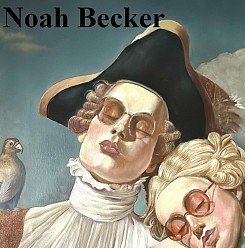Whitehot Magazine
January 2026
"The Best Art In The World"
"The Best Art In The World"
January 2026
Joel Murray and Clint Bargers have curated their annual "Chateau Chateau" show with the work of twenty artists at the Aldredge House
 Kristen Cochran, Temporary Housing, 2023, waiting-room fish tank footage projection. Chateau Chateau exhibition, Dallas Texas.
Kristen Cochran, Temporary Housing, 2023, waiting-room fish tank footage projection. Chateau Chateau exhibition, Dallas Texas.
By MELISA ELIF GERECCI October 4, 2023
It’s a warm Saturday afternoon in late September. Joel Murray and Clint Bargers have curated their annual Chateau Chateau show with the work of twenty artists at the Aldredge House, a Gilded Age mansion on Swiss Avenue, here in Dallas Texas. The home is stuffed with period furniture and antique décor—it’s a museum. What happens when contemporary artists are invited in?
Good, unsettling things, it turns out. As I explored the show, I often couldn’t be sure where a piece belonged—was it part of the house or part of the show? Long felted pillows atop a Queen Anne’s table on the second floor were the right size for the surface, making me question if someone set them down for just a moment, on their way to fluff cushions in the next room. Turns out they were inserted by Jesse Morgan Barnett, and too well to be an accident. Marjorie Norman Schwarz’s gauzy painting of peony-pink chairs, propped against a mirror behind the chairs themselves, was not at all out of place. It is the nearly seamless engagement of these works with their surroundings that made their discovery so rewarding. Jess Baldivieso’s soft, tactile prints were so in tune with nearby furnishing that their twenty-first-century material took a moment to register. So too did Angel Faz’s watery hand, projected on the first-floor staircase landing. The rope work by Krista Chalkley and terra-cotta sol by Daniel Rios Rodriguez, in the solarium, alluded to exclusion by introducing subjects (and artists) ideal for the site but unlikely to have ever found a home in a 1920s manse of a Dallas enclave. Bravo to the artists and curators for elucidating this history.
When I wasn’t standing still, studying to see what appeared, the show became a scavenger hunt, letting me roam the warren of rooms to find paintings, drawings, and sculptures. No doubt I wouldn’t have visited the house for this long or looked this closely had I not come to see the art. I had questions as I found each piece. Has this always been here? Who put it there? Should this be here?
Most installations answered NO, emphatically. Take Trey Burns’s LED-framed mirror behind a video projection connected to a solar-energy-powered cooler. Or Kristen Cochran’s shrunken, silicone cats framing the front door. Keer Tanchak’s dancer portraits were similarly mischievous—both her upstairs one, by a dictionary opened to “stripper” (n. “one who strips”), and her Showgirls painting above a silver tea service downstairs, jesting with the nearby portrait. That grave man, eyeing the woman licking a pole, was also treated to Tam Johnson’s pewter saltine, festooned with a cheeze-whiz smiley face and mercifully lightening the heavy surrounds. As did Bargers’s sculptural hunk of leather-n-marble, served on a silver platter and precarious on a bar cart. Freaky food continued upstairs: would you gobble a deviled egg off a vanity, on a mirrored tray, no less? In the kitchen, Ludwig Schwarz’s crime scene of scattered spice, reeling projections of garlic, and a cheap dry-erase board of fictional past performances called itself the FOUR SEASONS. Inappropriate, all of it!
 Jess Baldivieso, inconclusive, 2023, acrylic on stretched canvas. Jess Baldivieso, Ongoing, 2023, acrylic and gesso on wood panel. Kristen Cochran, House Cats (for the birds), 2023, bread, birdseed, place settings. Dallas Texas.
Jess Baldivieso, inconclusive, 2023, acrylic on stretched canvas. Jess Baldivieso, Ongoing, 2023, acrylic and gesso on wood panel. Kristen Cochran, House Cats (for the birds), 2023, bread, birdseed, place settings. Dallas Texas.
But playing with propriety was the goal. Showing contemporary work with storied collections enlivens both, reinvigorating the permanent collection while testing the new blood. Like any important structure, an institution can breathe only when interrogated, and it can really live when tickled or poked. The show reminds us that a house, even a stately one with a historic placard in a protected district, is ultimately a pile of sticks. Structures start eroding once they’re “complete”, aging after opening night.
One way to preserve institutional power is to redistribute it: welcome the energy that comes with different takes. Recognize any institution as unfinished work. Take down a statue or just toss seasoning on the kitchen counters. Overturn those eight-person tables—or set them properly, then plate them with cats made of bread, as one artist did here. Chateau harnesses dozens of installations to create an intervention. It interrupts standard-museum and contemporary-art-show narratives. Should I be here? I wondered. Would I come back? Am I in a public place—or private home?
 River Shell, Baby You’re a Rich Man Too, 2023, ink on stretched cotton flour sack. Dallas Texas.
River Shell, Baby You’re a Rich Man Too, 2023, ink on stretched cotton flour sack. Dallas Texas.
Around six o’clock, a letter carrier walked up the sidewalk on Swiss Avenue. He wore reflective sunglasses and shorts as he dropped off an AT&T bill. This art venue was still part of everyday life. It felt like a personal collection shared with friends, and few things delight like that. It didn’t feel like an institution with policies, even though the house’s current owner, the Dallas County Medical Association, surely has them. Idiosyncratic, private collections are a joy to experience. With the objects, they reveal acquisition and placement histories, many deeply personal. They’re unabashedly themselves. This show achieved that vibe while broadening access, an accomplishment usually reserved for museums. Above all, Chateau Chateau is a show about possession, stewardship, and interpretation. How do we use the space we’re in? What space are we given—or do we have to take it? Are we seen in the spaces we occupy?
The artists and curators (who are artists themselves) toy with these questions and advocate for opening institutions up for play and experimentation. Murray also works as the caretaker of the house. Curator as caretaker—I want more of that in our world. River Shell’s blurred text, painted on a small canvas propped above dressing room mirrors, required lifting my gaze and squinting my eyes, a subtle comment on what commands our attention and the powerful draw of mirrors. Zeke Williams’s textured birds popped out of bath tubs and darted across the roof, roaming wild, startling in the way nature can when it enters controlled space. Perhaps Cochran’s sunken dining room says it best, that mise en scène of overturned tables transformed into screens for projections of swimming fish. She responded to the here and now while raising questions without requiring answers. Site-specificity met subversive and became Beauty. WM

Melisa Elif Gerecci
Melisa Elif Gerecci is an artist working in Newark, Istanbul, and Dallas. Her work is held by the Newark Public Library-Special Collections and in private collections. Recent commissions include a mural for Audible's global headquarters at Innovation Cathedral and a sculpture on the East Coast Greenway. Gerecci's art may be found here.
Photo by Rachel Fawn Alban for the Newark Artist Collaboration.









